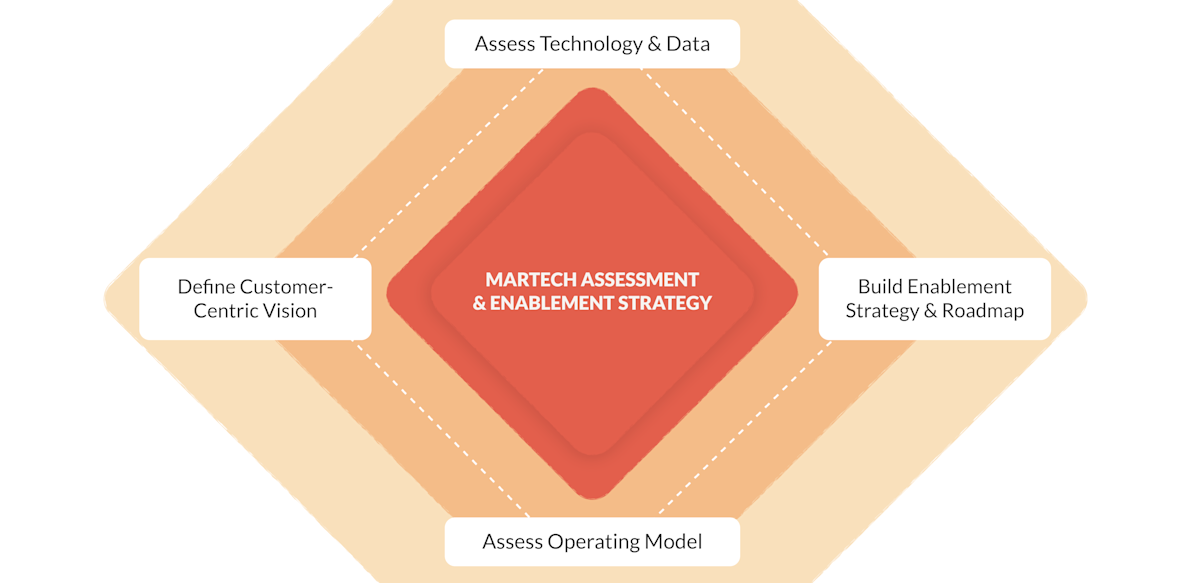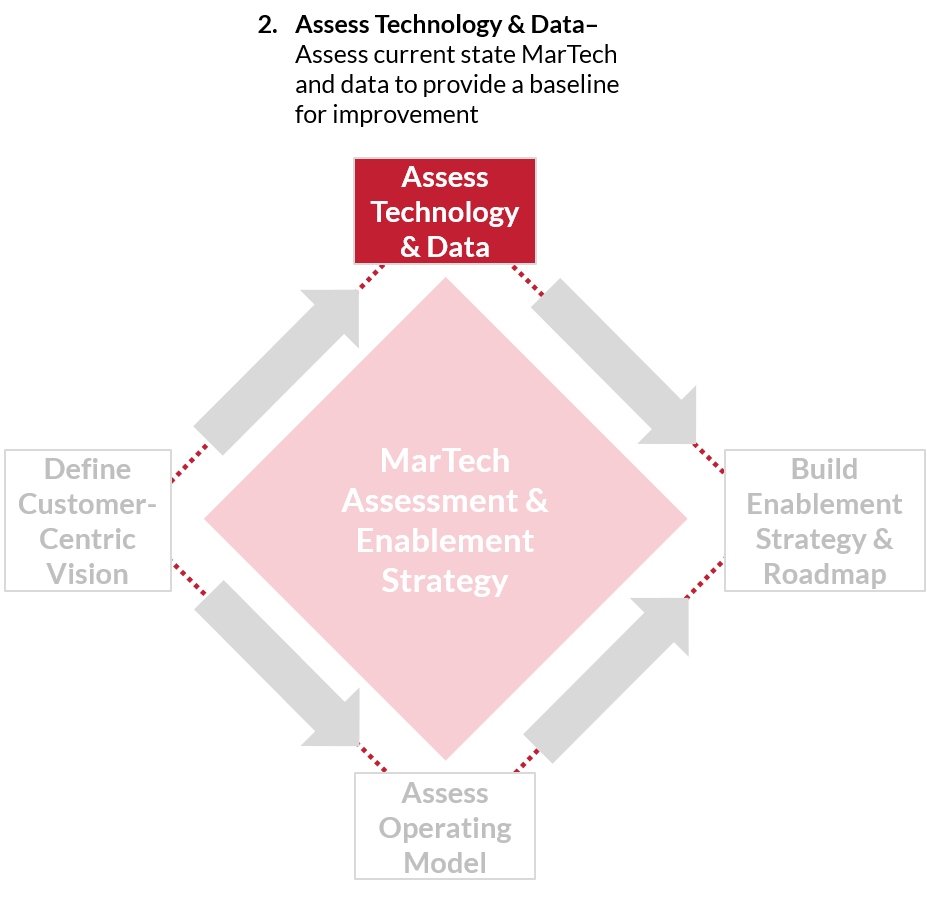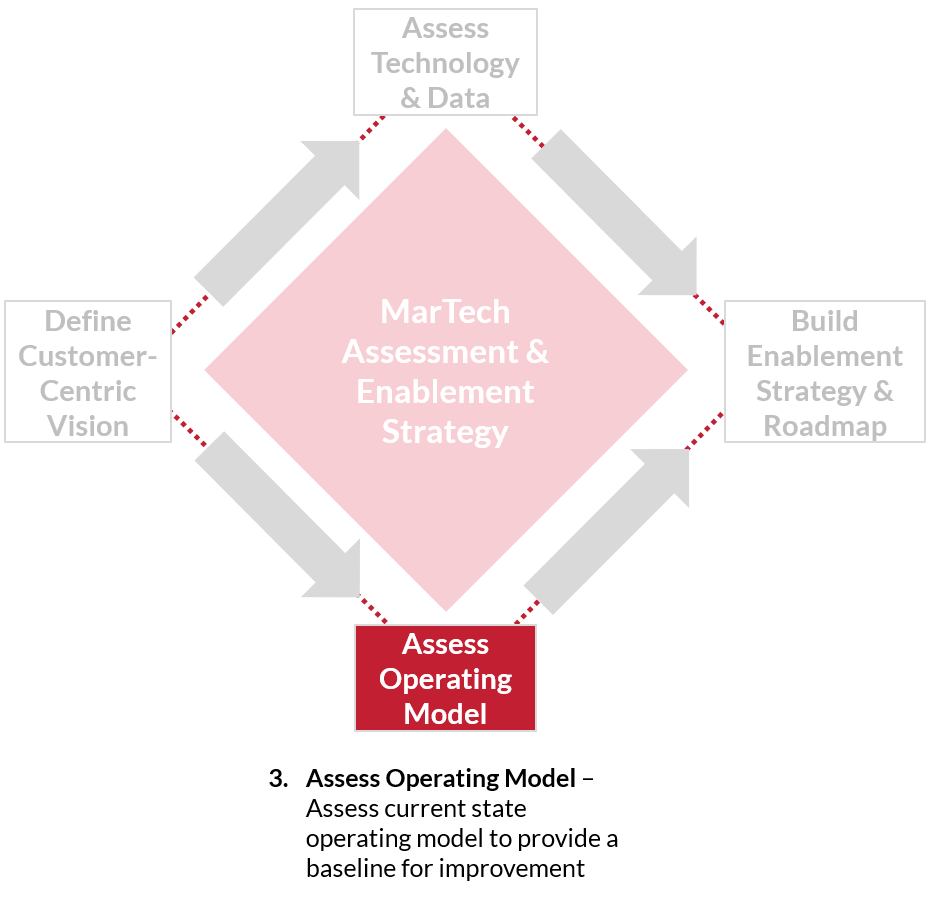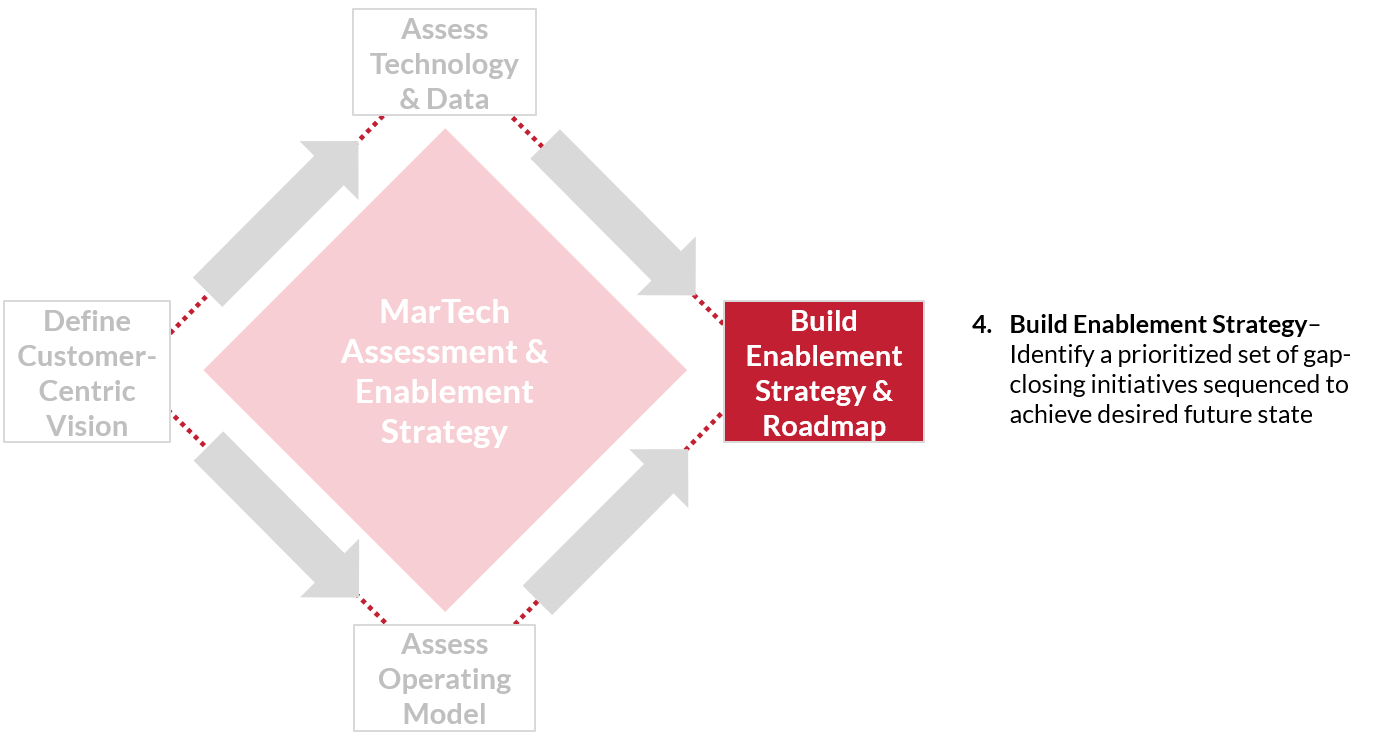
Today’s consumers demand relevant, timely experiences across all interactions with a brand. As such, marketers must be prepared to engage customers with the right content from the right channel in a timely manner. If you are a marketer in 2020, this assertion, and the statistics below, should not surprise you:
Personalization can reduce acquisition costs by as much as 50% and increase marketing spend efficiency by 10-30%
Data-activated marketing based on a person’s real-time needs can boost total sales by 15-20%
Even though this consumer expectation is widely acknowledged, marketers are not using their data and Marketing Technology (MarTech) solutions effectively to drive customer experiences. This disconnect between customer expectations and marketers’ realities makes sense when you consider all that goes into establishing and optimizing a MarTech-enabled marketing organization. From consolidating disparate data sources into a unified customer view, to generating and managing “intelligent content”, to delivering the ‘next best action’ for each customer to owning and analyzing your own data – the growth opportunities for Marketers are endless and quite frankly – can be overwhelming.
This is where Credera’s MarTech Assessment and Enablement Strategy comes in.
What Is a MarTech Assessment?
Credera’s MarTech Assessment & Enablement Strategy is our client-tested approach to help companies achieve their customer-facing goals, by establishing the technology, data, and processes required to excel as a modern marketer. We partner with clients to assess their marketing systems and data, within the context of their customer-centric vision and their operating model, to outline the short-term and long-term steps needed to achieve their business objectives.

Defining the Customer-Centric Vision As mentioned above, personalization is critical for increasing the relevance and impact of marketing activities. In order to personalize marketing communications, it is critical to begin with the customer in mind. The mindset of a customer, his/her previous behaviors, and attributes about that customer all contribute to where the customer is in his or her specific journey. Marketers can maximize their influence on the customer if they first understand the customer’s decision cycle and meet him/her at those pivotal moments with the right message in the best channel. This means it is important to design the desired customer experience into and around their journey. This is the customer-centric vision.
Beyond being able to envision the desired customer experience, it is equally important to determine up-front how this vision comes to life via use cases describing the people, processes, and technologies employed. To determine whether these use cases can actually be delivered in the current environment, we dig into the next stages of the effort – assessing the technology, data, organization, and business processes.

Assessing the Technology and Data In order to deliver personalized marketing at scale, many marketing activities need to be automated. In a beneficial (and challenging) way, there are over 8,000 MarTech solutions available, ranging from enterprise product suites to fledgling startups, to help automate and optimize various pieces of the marketing puzzle. This overload of MarTech stack options often results in marketers not knowing where to start and gets in the way of an organization’s ability to deliver. It is critical, therefore, to understand the solutions and capabilities currently in place before making additional investments. However, don’t let the existence of a tool by itself suggest that all of its features are being fully utilized; solutions are frequently implemented sub-optimally or not integrated to other components in the architecture. Understanding the customer experiences being delivered today can help clarify what MarTech capabilities are actually in-place.
A component equally important to MarTech in delivering personalization is the data that fuels it. Without customer data (i.e., characteristics, behaviors, preferences, previous interactions, etc.), personalization is limited at best. Understanding where this data is sourced, how it is integrated between different technologies, how it is employed in making marketing decisions, and how performance is measured are all important to consider when assessing current state technology and data.

Assessing the Operating Model MarTech and automation are important for delivering widescale personalization across channels, but people are still a critical piece of the planning, execution, and measurement of marketing tactics. The way the work of marketing occurs can often be a bottleneck of its own, beyond any constraints caused by the challenges of the MarTech and data. With some teams following agile Kanban or Scrum, other teams following a waterfall approach to delivery, and functional teams generally interacting within themselves without sufficient cross-functional collaboration, current operations are often disjointed and inefficient.
Understanding the current state operating model (through both formal and informal structures and processes) can help everyone temporarily step outside the fray of day-to-day operations and acknowledge the pain points and inefficiencies of the current state. Equipped with this information and an accurate picture of the current state MarTech and data, it becomes easier to now identify the gaps that will prevent the desired future state customer experiences from being realized.

Building an Enablement Strategy and Roadmap The intent of the assessment activities outlined above is to identify where an organization’s current capabilities exist from people, process, and technology perspectives. The current capabilities are compared against those required to deliver the desired customer experience use cases, and a set of gaps are identified that prevent these from coming to life. These gaps are then considered individually and collectively to compile a set of initiatives that would be used to close the gaps. Initiatives are prioritized based on their estimated effort and impact, and then sequenced along with any ongoing initiatives.
The output of this prioritization and sequencing exercise is a strategic roadmap laying out the MarTech enablement activities for the next 12-24 months. Using this roadmap, an organization can begin taking ground on enhancing its data, technology, and operating model in order deliver the desired customer experiences that will improve acquisition, retention, and win-back efforts.
5 Signals That a MarTech Assessment Is a Good Choice
So why should a marketer carve out time to assess their marketing capabilities? The answer is right there: expectations, complexity, and disruptions will only continue to rise at an increasing pace. Shortcomings in marketing capabilities will handicap even the best brand’s ability to compete on customer experience. Still not sold on getting started now? Here are five of the most common signs that a marketing organization would benefit from a MarTech Assessment and Enablement Strategy:
Sign #1: Lack of Personalization
Brands are winning (or losing) based on customer experiences. Modern customers expect relevant content and engagement based on their prior behaviors. The following signals could mean a lack of progress in this crucial area:
Large presence of ‘one-size fits all’ campaigns and customer experiences. If your prospects and customers are generally receiving the same content, are the barriers to increased personalization due to missing data, lack of toolset integration, cross-team process challenges or a combination of all three?
Lack of measurable progress against aspirational ‘Vision Statements’ to become more customer-centric
Material decline in KPI’s for customer engagement, conversion and overall satisfaction
Sign #2: Incomplete View of Customers
Customer data is the fuel that powers remarkable experiences. However, many organizations struggle to unify, consolidate, and activate massive quantities of customer data in a timely manner. Evidence of an incomplete customer view includes:
Structured and unstructured customer data often lives in siloed repositories or outside of the marketing organization
Lack of a customer ‘golden-record’ to unify all customer attributes
Legacy batch ETL processes do not support real-time activation of contextual customer experiences
Sign #3: Non-Optimized MarTech Stack
At this point, almost all marketing organizations have invested heavily in MarTech. According to Gartner, MarTech spend as a percentage of marketing budgets eclipsed 29% in 2018. Despite this investment, many marketing organizations have partial toolset deployments or lack of integration across platforms that prevents full benefits realization. Signs that the current MarTech stack could be optimized include:
Perceived lack of ROI on MarTech investment for some (or many) vendors, or duplicated/overlapping functionality across vendors
Over-reliance on manual processes that could be automated and optimized with technology (e.g., triggered ‘next best actions’ based on predictive algorithms)
Noticeable gaps in common MarTech functionality (e.g., consent management, identity resolution, intelligent content, AI/ML, etc.)
Inability to deliver marketing use cases because of a lack of integration between MarTech platforms
Sign #4: Outdated Organizational Model
Many organizations align their marketing team around channels, which can create confusing customer experiences if not seamlessly orchestrated. Further, as marketing becomes more technology-driven, greater collaboration between CMOs and CTO/CIOs will be required. Common challenges include:
Marketing departments are still orienting teams around channels or campaigns, which often creates conflicting and confusing customer experiences
Rolling out new, personalized customer experiences takes months (or quarters) instead of weeks
There is a tangible divide between Marketing and IT, which inhibits agility and progress
Sign #5: Legacy IT Inertia
Recent studies show Marketing and IT working more closely together, building effective partnerships. Despite this progress, annual budgeting processes, legacy technical decisions, and/or aging infrastructures can delay the speed-to-market for organizations looking to modernize their marketing technology capabilities. Typical signs include:
Ad hoc requests from Marketing for IT assistance with MarTech tools do not fit into existing IT planning, funding or staffing cycles – leading to delayed speed to market for new marketing capabilities
Ambiguity between Marketing and IT on technical and functional/operational ownership of MarTech platforms
Legacy IT infrastructure hampers efforts to activate best-of-breed marketing capabilities with the speed the market requires
Moving Forward
If you are interested in learning how Credera’s MarTech Assessment and Enablement Strategy offering could help your organization, we have a dedicated team of MarTech strategists ready to help you develop an action plan for enabling advanced Marketing capabilities with technology and data. If you would like to learn more, reach out to our team at marketing@credera.com.
Contact Us
Ready to achieve your vision? We're here to help.
We'd love to start a conversation. Fill out the form and we'll connect you with the right person.
Searching for a new career?
View job openings






